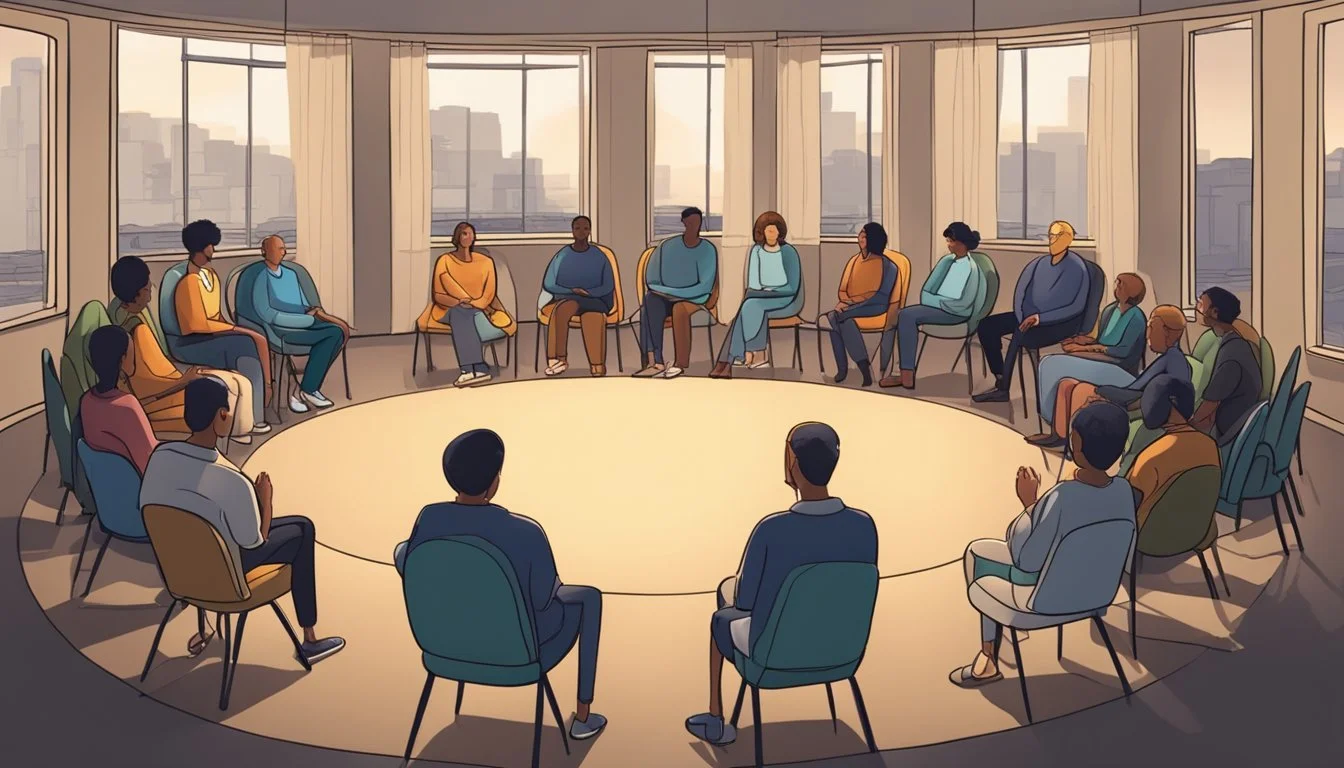Finding Strength Together: The Power of a Toxic Relationship Support Group
Toxic relationships can leave deep emotional scars, but support groups offer a path to healing and recovery. These groups provide a safe space for survivors to share experiences, learn coping strategies, and rebuild self-esteem. Support groups for toxic relationship survivors typically meet regularly, either in-person or online, and are facilitated by mental health professionals or trained peer leaders.
Participants in toxic relationship support groups often find comfort in connecting with others who have faced similar challenges. The shared experiences help validate feelings and reduce isolation. Group members learn to recognize patterns of abuse, set healthy boundaries, and develop tools for navigating future relationships.
Many organizations offer specialized support groups for survivors of toxic relationships. These include domestic violence hotlines, community mental health centers, and online platforms dedicated to narcissistic abuse recovery. Joining a support group can be an important step in breaking free from toxic patterns and fostering personal growth.
Identifying Toxic Relationships
Recognizing the signs of a toxic relationship is crucial for protecting one's emotional and psychological well-being. These harmful dynamics often involve patterns of behavior that undermine trust, respect, and support between partners.
Recognizing Manipulation and Control Tactics
Manipulation in toxic relationships can take many forms. Gaslighting is a common tactic where the abuser denies or distorts reality, making the victim question their own perceptions.
Excessive criticism and belittling comments are used to erode self-esteem. The abuser may use guilt trips or emotional blackmail to control their partner's behavior.
Financial control is another manipulative tactic. The abuser may restrict access to money or demand detailed explanations for every expenditure.
Isolating the victim from friends and family is a common control tactic. This limits external support and makes the victim more dependent on the abuser.
Understanding the Cycle of Abuse
The cycle of abuse typically consists of four phases: tension building, incident, reconciliation, and calm.
During tension building, stress increases and communication breaks down. This leads to the incident phase, where verbal, emotional, or physical abuse occurs.
The reconciliation phase follows, with the abuser apologizing and promising change. This may include gifts or increased affection.
The calm phase, also known as the honeymoon phase, is a period of relative peace. However, tensions eventually begin to build again, restarting the cycle.
Red Flags and Warning Signs
Jealousy and possessiveness are common red flags in toxic relationships. The abuser may constantly accuse their partner of infidelity or demand access to their personal communications.
Frequent mood swings and unpredictable reactions can create an atmosphere of fear and uncertainty. The victim may feel like they're "walking on eggshells" around their partner.
Lack of respect for boundaries is another warning sign. This can include physical boundaries, emotional boundaries, or disregard for privacy.
Constant put-downs or humiliation, especially in public, indicate a toxic dynamic. The abuser may disguise these as "jokes" but they serve to undermine the victim's confidence.
Refusal to take responsibility and shifting blame onto the victim are common in toxic relationships. The abuser may always have an excuse for their behavior.
Effects of Toxic Relationships
Toxic relationships can have profound and lasting impacts on mental health and well-being. These harmful dynamics erode self-worth, trigger anxiety and depression, and leave emotional scars that can persist long after the relationship ends.
Impact on Self-Esteem and Self-Image
Constant criticism and manipulation in toxic relationships chip away at self-esteem. Victims often internalize negative messages, leading to feelings of worthlessness and self-doubt.
The cycle of emotional abuse can cause individuals to lose sight of their own needs and values. This erosion of identity makes it difficult to trust one's own judgment.
Gaslighting tactics employed by toxic partners further damage self-image. Victims may question their own perceptions of reality, leading to confusion and insecurity.
Anxiety, Depression, and PTSD
Toxic relationships frequently trigger anxiety disorders. The unpredictable nature of abuse keeps victims in a state of hypervigilance.
Depression commonly develops as a result of ongoing emotional trauma. Feelings of hopelessness and despair can become overwhelming.
Post-traumatic stress disorder (PTSD) may occur in severe cases. Flashbacks, nightmares, and intense emotional reactions to triggers are common symptoms.
Panic attacks and social anxiety often persist even after leaving the toxic relationship. Trust issues make it challenging to form new connections.
Long-Term Psychological Impact
The effects of toxic relationships can linger for years. Many survivors struggle with codependency in future relationships.
Difficulty setting boundaries is a common long-term consequence. Victims may have trouble recognizing healthy relationship dynamics.
Unresolved trauma can manifest as chronic health issues. Stress-related conditions like fibromyalgia and autoimmune disorders are more prevalent in abuse survivors.
Healing requires professional support and time. Therapy, support groups, and self-care practices are essential for overcoming the lasting impacts of toxic relationships.
Healing and Recovery
Recovering from a toxic relationship requires time, effort, and support. The journey involves embracing the healing process, developing coping strategies, and building resilience.
Embracing the Healing Process
Healing begins with acknowledging the impact of the toxic relationship. Survivors must recognize that recovery unfolds gradually and give themselves permission to heal at their own pace. Self-reflection plays a crucial role in understanding the patterns that led to the toxic dynamic.
Therapy can provide valuable guidance during this phase. A mental health professional can help individuals process their experiences and develop healthy coping mechanisms. Cognitive-behavioral therapy (CBT) is often effective in addressing negative thought patterns stemming from toxic relationships.
Journaling can also aid in the healing process. Writing about experiences and emotions helps survivors gain clarity and track their progress over time.
Coping Strategies and Emotional Support
Developing a toolkit of coping strategies is essential for managing difficult emotions and situations. Some effective techniques include:
Deep breathing exercises
Mindfulness meditation
Physical exercise
Creative outlets like art or music
Support groups offer a unique opportunity for individuals to connect with others who have faced similar challenges. These groups provide a safe space to share experiences, learn from others, and receive emotional support.
Building a strong support network of trusted friends and family members is crucial. Having people to lean on during tough times can make a significant difference in the recovery process.
Building Resilience and Empowerment
Resilience is key to overcoming the effects of a toxic relationship. Survivors can build resilience by:
Setting and enforcing healthy boundaries
Practicing self-care regularly
Cultivating a positive self-image
Developing new skills and interests
Empowerment comes from recognizing personal strengths and reclaiming autonomy. This may involve making decisions independently, pursuing personal goals, and rediscovering individual identity outside of the relationship.
Education about healthy relationships is vital. Learning to recognize red flags and understand what constitutes a healthy partnership helps prevent future toxic dynamics.
Support Systems
Support systems play a crucial role in helping individuals heal and recover from toxic relationships. They provide essential emotional assistance, practical resources, and guidance for those seeking to rebuild their lives.
Finding and Utilizing Support Groups
Support groups offer a safe space for survivors of toxic relationships to share experiences and coping strategies. Many communities have local groups that meet regularly, often organized by therapists or community centers. Online support groups provide accessibility for those unable to attend in-person meetings. These groups foster a sense of community and understanding among participants.
Participants can benefit from hearing others' stories, learning new coping skills, and receiving encouragement. Support groups often focus on rebuilding self-esteem, setting healthy boundaries, and recognizing toxic behaviors. Regular attendance can significantly aid the healing process and help individuals develop stronger, healthier relationships in the future.
Role of Family and Social Support
Family and friends form a vital support network for those recovering from toxic relationships. They can provide emotional comfort, practical assistance, and a sense of security. Trusted family members and friends can offer a listening ear, help with daily tasks, or provide temporary housing if needed.
Social support helps combat feelings of isolation often experienced by those leaving toxic relationships. It's important for survivors to reconnect with positive influences in their lives and rebuild social connections. Supportive relationships can help restore trust and confidence, which are often damaged in toxic situations.
Resources: Domestic Violence Centers and Hotlines
Domestic violence centers and hotlines are essential resources for those in or leaving toxic relationships. These organizations offer:
24/7 crisis hotlines
Emergency shelter
Legal advocacy
Counseling services
Safety planning
The National Domestic Violence Hotline provides confidential support and information. Local domestic violence centers often have trained staff who can offer personalized assistance and connect individuals with community resources.
Many centers provide support groups, individual counseling, and educational programs. These resources are crucial for immediate safety and long-term recovery, offering both crisis intervention and ongoing support for survivors of toxic relationships.
The Role of Therapy
Therapy plays a crucial part in healing from toxic relationships. It provides tools and support for processing emotions, rebuilding self-esteem, and developing healthier relationship patterns.
Individual Therapy and Group Therapy
Individual therapy offers personalized attention to address specific issues stemming from toxic relationships. A therapist can help identify unhealthy patterns, work through trauma, and develop coping strategies. This one-on-one approach allows for deeper exploration of personal experiences.
Group therapy provides a supportive environment where individuals can share their stories and learn from others. Participants gain insights, validation, and a sense of community. This setting helps reduce feelings of isolation and shame often associated with toxic relationships.
Both forms of therapy can be beneficial, and many people find value in combining the two approaches.
Working with Mental Health Providers
Mental health providers offer specialized expertise in addressing the psychological impact of toxic relationships. Psychologists, counselors, and social workers can provide evidence-based treatments tailored to individual needs.
These professionals use various techniques such as cognitive-behavioral therapy, trauma-informed approaches, and interpersonal therapy. They help clients process emotions, challenge negative thought patterns, and develop healthier coping mechanisms.
Mental health providers can also diagnose and treat related mental health conditions that may have developed due to toxic relationships, such as depression or anxiety.
Integrating Self-Help Techniques
Self-help techniques complement professional therapy and support ongoing healing. These methods empower individuals to take an active role in their recovery process.
Common self-help strategies include:
Journaling to process emotions and track progress
Practicing mindfulness and meditation for stress reduction
Reading self-help books on healthy relationships and personal growth
Engaging in regular exercise for physical and mental well-being
Therapists often encourage the use of these techniques between sessions to reinforce skills learned in therapy. Self-help methods provide tools for managing day-to-day challenges and promoting long-term healing.
Creating a Supportive Environment
A supportive environment is crucial for healing from toxic relationships. It provides a foundation for personal growth, emotional safety, and positive interactions. Members learn to establish boundaries, foster respect, and naviate complex family dynamics.
Establishing Healthy Boundaries
Setting clear boundaries is essential in toxic relationship support groups. Members learn to identify their limits and communicate them effectively. This process involves recognizing personal needs and asserting them without guilt or fear.
Boundaries can be physical, emotional, or digital. Examples include:
Limiting contact with toxic individuals
Saying "no" to unreasonable requests
Protecting personal space and privacy
Group facilitators teach techniques for enforcing boundaries consistently. Role-playing exercises help members practice these skills in a safe setting. Participants also learn to respect others' boundaries, creating a culture of mutual consideration.
Fostering Mutual Respect and Safe Interactions
Support groups cultivate an atmosphere of mutual respect and safety. This environment allows members to share experiences without fear of judgment or criticism. Ground rules are established to ensure respectful communication:
Active listening without interruption
Using "I" statements to express feelings
Avoiding blame or personal attacks
Facilitators model empathy and compassion, encouraging members to do the same. Trust-building exercises help participants feel more comfortable opening up. Confidentiality is strictly maintained to protect everyone's privacy and promote honest sharing.
Navigating Toxic Relationships in Family Dynamics
Family relationships often present unique challenges when dealing with toxicity. Support groups address these complex dynamics, helping members:
Identify unhealthy family patterns
Develop strategies for managing difficult relatives
Set boundaries with family members
Participants learn to recognize manipulation tactics common in toxic family systems. They explore ways to maintain their well-being while navigating family obligations. The group provides a space to practice new communication skills and problem-solving techniques.
Members share experiences and offer support to those struggling with similar family issues. This peer support helps reduce feelings of isolation and guilt often associated with family conflicts.
Understanding Narcissistic Abuse
Narcissistic abuse is a form of emotional manipulation and control that can have devastating effects on victims. It stems from a pattern of behaviors exhibited by individuals with narcissistic traits or Narcissistic Personality Disorder (NPD).
Narcissistic Traits and Behaviors
Narcissists often display grandiosity, a need for admiration, and a lack of empathy. They may engage in love bombing, gaslighting, and triangulation to maintain control. Narcissists frequently belittle others, take credit for others' accomplishments, and react with rage when criticized.
Common narcissistic behaviors include:
Excessive self-importance
Preoccupation with fantasies of success or power
Belief in their own uniqueness or superiority
Expectation of constant praise and admiration
Sense of entitlement
Exploitation of others for personal gain
These traits can manifest in various ways, making relationships with narcissists challenging and often harmful.
Dealing with Narcissistic Personality Disorder (NPD)
NPD is a mental health condition characterized by an inflated sense of self-importance and a deep need for attention and admiration. Individuals with NPD may appear confident, but often mask fragile self-esteem.
Dealing with someone who has NPD can be difficult. It's important to:
Set clear boundaries
Practice self-care and seek support
Avoid engaging in arguments or power struggles
Recognize manipulation tactics
Seek professional help if needed
Treatment for NPD typically involves long-term psychotherapy. However, many individuals with NPD resist treatment as they don't believe they have a problem.
Signs of Narcissistic Abuse and Recovery Path
Narcissistic abuse often leaves victims feeling confused, anxious, and emotionally drained. Signs of narcissistic abuse include:
Constant criticism and put-downs
Emotional manipulation and gaslighting
Isolation from friends and family
Feelings of worthlessness or self-doubt
Walking on eggshells to avoid conflict
Recovery from narcissistic abuse is possible. It often involves:
Acknowledging the abuse
Seeking therapy or counseling
Rebuilding self-esteem and confidence
Establishing healthy boundaries
Practicing self-care and healing techniques
Joining support groups can be beneficial, providing validation and understanding from others who have experienced similar betrayal and trauma.




